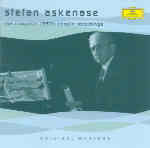Pianist Stefan Askenase (1896-1985) was known for his Chopin interpretations in addition to his reputation as a teacher, whose pupils include such luminaries as Martha Argerich and Mitsuko Uchida. Here his Chopin recordings from the 1950s are reissued for the first time in one place on CD, together with sundry fillers and a pair of recitals dating from the pianist’s later years. In the main, Askenase is an intimate rather than a heroic Chopinist who often shapes phrases in clipped, salon-like patterns that embody many layers of color, nuance, and touch. For the most part he stresses the composer’s inherent classicism more than his surface bravura. Collectors familiar with Wilhelm Kempff’s similarly scaled Beethoven sonata recordings will find something of a kindred spirit in Askenase’s artistry.
As with nearly all the great and near-great Chopin stylists, certain genres suit Askenase’s temperament more than others. Compared to the pomp, swagger, and infectious rhythm distinguishing Arthur Rubinstein’s Polonaises, for example, Askenase sounds underpowered. Both sonatas feature exquisite details (the striking contrapuntal clarity in the B minor first movement) alongside shaky technical moments (the B-flat minor first movement’s unevenly dispatched triplet chords). Some of the Op. 28 Preludes fall short of their expected dynamism and assurance (Nos. 3, 8, 12, 14, and 19). Others prove revelatory. Askenase leans on No. 2’s knife-twisting dissonances with the weight of the world. He begins No. 4 at a whisper and incrementally steps up the conversational tension between the melody and processional left hand chords. No. 5’s interlocking lines gain uncommon clarity through the pianist’s probing rubato, and he throws away the final chords to surprising effect.
There’s more sophistication to Askenase’s Nocturnes than their casual lyricism betrays. The pianist’s careful accents and gradations of tone intensify Op. 15 No. 3’s cross-rhythmic accompaniments with little recourse to rubato. By contrast, liberal modifications of pulse mark Op. 55 No. 2, yet the overall impression is remarkably straightforward and compact, approaching the proportion and easy fluidity of Ignaz Friedman’s classic account. Askenase’s clipped and jovial phrasing of Op. 55 No. 1’s opening section gives no hint of the agitation to come.
The faster Waltzes stand out for Askenase’s full-bodied staccato articulation (an accomplishment easier said than done) while the slower ones allow room for real and implicit inner voices to cast benign shadows. Like Cortot, Rosenthal, and Rachmaninov, Askenase creates a contrapuntal effect by slightly elongating the lowest note in the C-sharp minor Waltz’s second theme.
Both concertos display Askenase’s rounded phrasing and tonal allure at their most genial. The First Concerto, recorded in stereo, boasts the decisive sonic edge, and so does the Krakowiak from the same sessions, where the pianist admirably scales the work’s tremendous technical hurdles. Though the two late recitals capture Askenase past his technical prime (the Third Scherzo and First Impromptu are a bit frayed around the edges), he is never less than 100 percent musically engaged. He makes the Second Scherzo’s unusually slow tempo work to his aged advantage by shaping small details with the utmost in tonal beauty and specificity (the opening triplets, for example) so that even the most outstretched phrases never drag. Both the Barcarolle and Berceuse are intelligently parsed and executed with seasoned care. Ditto the delicious Schubert dance medley, the Liszt pieces, the impeccably timed Smetana Polkas, and ample, unpressured Mendelssohn selections. Last but hardly least–I must mention Askenase’s breathtaking poise and winged precision in the Mozart B-flat K. 570 sonata. It’s a gem of a performance, and I wouldn’t be surprised if you return to it more often than the Chopin items. DG’s transfer work is beyond cavil.
































